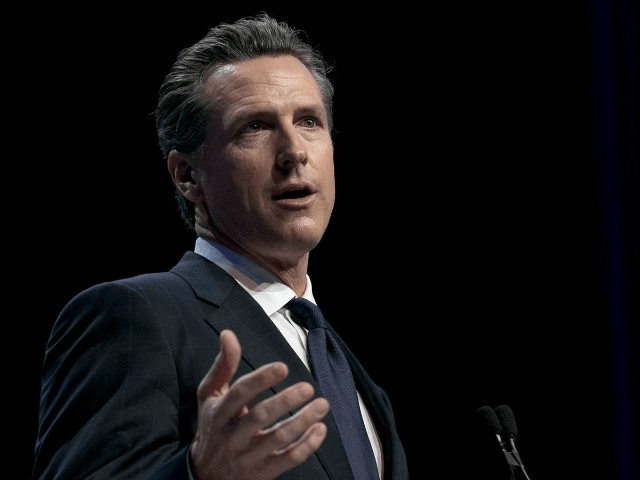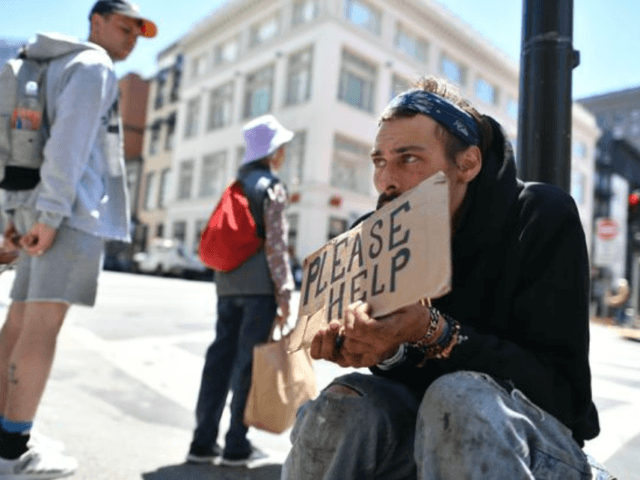“Democrat lawmakers care more about illegal aliens than they care about their own constituents,” he said.
Gov. Gavin Newsom’s Remark on Homelessness Crisis in San Francisco Rated ‘Pants on Fire’

4:56
California Gov. Gavin Newsom (D) is under fire for neglecting the homelessness crisis festering in his state.
PolitiFact recently rated one of his remarks “Pants on Fire” after he claimed that the “vast majority” of the homeless population in San Francisco comes from Texas:
California Gov. Gavin Newsom said that the "vast majority" of San Francisco's homeless people come from Texas...is that true?
No way. We rated this claim Pants on Fire! politifact.com/california/sta… via @CAPolitiFact
28 people are talking about this
“The vast majority (of San Francisco’s homeless people) also come in from — and we know this — from Texas. Just (an) interesting fact,” Newsom said during an interview with Axios on HBO in June.
“San Francisco’s own homeless surveys contradict this. They show a large majority reported living in the city before becoming homeless, and just a fraction coming in from out-of-state,” PolitiFact assessed.
It continued:
Newsom’s office pointed to data from San Francisco’s bus ticket program for homeless people. But that defense doesn’t hold up. It shows just a small fraction, less than 7 percent, left for Texas, and doesn’t demonstrate that they originally came to San Francisco from that state.In the end, we found Newsom made a ridiculous claim.We rated it Pants on Fire.
Newsom’s problematic remark only added to the mounting tensions in the state.
Sacramento salon owner Elizabeth Novak recently posted a viral video directed at Newsom, detailing how the unaddressed homelessness crisis in the state is affecting her business.
“I’ve had a business in downtown Sacramento for 15 years. I just want to tell you what happens when I get to work: I have to clean up the poop and the pee off of my doorstep,” she said in the viral post.
“I have to politely ask people, who I care for, I care for these people who are homeless, to move their tent,” she continued. “So, I want to know what you’re going to do for us”:
Because of that, she is forced to move her business elsewhere, telling Fox News that she is “never sure what [she is] going to walk into” when she goes to work every day.
“When I come into work, I’m never sure what I am going to walk into. I’ve been broken into; I’ve had my glass broken; I clean up human excrement off of my doorstep every week, cups of urine, things like that,” she explained.
“And, I do have compassion for these people – but, they’re sleeping in front of your door and they’re leaving trash and they’re turning over garbage cans, and I can’t do that anymore,” she continued, explaining that some of the roots of the issue – such as drug abuse – have yet to be properly addressed.
Homelessness has been an ongoing problem, particularly in San Francisco and Los Angeles.
According to a June report, the homeless population jumped 12 percent in the last year alone in Los Angeles County, “nearly 59,000 living on the streets.”
As Breitbart News reported:
The newly released data revealed that nearly three-fourths of the homeless population, which includes 58,936 people, are sleeping in cars, tents, and other make-do shelters.Released by the Los Angeles Homeless Services Authority to the Board of Supervisors, the data found that the majority of homeless people were residing in the city of Los Angeles, which saw an increase of 16 percent to 36,300.
Additionally, an estimated 16,000 live in cars, according to the Los Angeles Times, spurring the creation of “safe parking” areas, which serve as an alternative to homeless shelters. However, the LA City Council recently reinstated an ordinance, banning people from sleeping in cars parked in residential areas.
“This law … is going to directly contribute to these people being on the street,” Mel Tillekeratne, executive director of nonprofit homelessness group The Shower of Hope said.
Meanwhile, San Francisco’s homelessness population has risen 17 percent in the last two years alone as the result of “the pressure of rising housing costs, and the social devastation of the opioid epidemic,” as Breitbart News reported.
Newsom signed California’s 2019-2020 state budget in June, pledging a “historic” $1 billion investment to address the crisis. According to the release, the investment will:
- Provide homelessness emergency aid to local governments for emergency housing vouchers, rapid rehousing programs and emergency shelter construction
- Increase mental health supports, which includes expanding Whole Person Care services that provide wrap-around health, behavioral health and housing services, and building strategies to address the shortage of mental health professionals in the public mental health system
- Fund rapid rehousing and basic needs initiatives for students in the University of California, California State University and California Community College systems
However, the state has yet to see any tangible improvements on the homelessness front.
EYE ON THE NEWS
August 20, 2019
Where Has the Money Gone?
San Francisco’s political leadership has squandered a fortune.August 20, 2019
California
Economy, finance, and budgets
Politics and law
In 2009, San Francisco’s municipal budget totaled $6.5 billion—$8.6 billion in today’s dollars, adjusted for inflation and population. San Francisco’s budget for 2019 is an eye-popping $12.2 billion, a 10 percent increase just since 2018. The city has failed to match this staggering budget growth with a similar increase in capital investment or services, however, providing an object lesson in the limits of what money can do.
Companies like Google, Salesforce, and Uber, headquartered in and around the city, pour sky-high salaries and stock-option windfalls into the local economy, which has seen real estate values—and the cost of everything else—soar. City coffers overflow with tax revenue. Though the effect has been most pronounced for the past decade, it extends as far back as the first dot-com boom, 20 years ago—in 1999, the city budget was $4.2 billion, equivalent to $7.7 billion today. The excess budget above inflation and population growth over those 20 years totals an astonishing $23 billion.
What has San Francisco done with this wealth? Not much. The Municipal Transportation Agency (“Muni”), which runs the busses and metro, has struggled with failure after failure this year. The housing shortage in the city is so bad that it is driving people to live in cars and even boats. Homelessness is up 14 percent in the past 6 years. Dirty streets, with needles and worse on the sidewalks, were an issue in last year’s mayoral race. A city seemingly rich enough to pave its roads with gold finds them covered in trash.
San Francisco has squandered its fortune. Proclaiming itself a “Transit First” city, density and geography make it one of the U.S. cities best suited for public transport. The city could have used its $23 billion excess to build dozens of miles of subway. Instead, it dug just 1.6 miles of the Central Subway, still not open. San Francisco did build a downtown train station, the Salesforce Transit Center, billed as the “Grand Central of the West”—except that it didn’t fund a tunnel to the station, so no trains go there yet, only busses.
San Francisco politicians also claim to care about affordable housing. Even at the inflated rate to build such housing in the Bay Area—up to $700,000 per unit—$23 billion could have built 33,000 units in the past 20 years. The total number of subsidized units in the city was only about 33,000 in 2018, and just 3,741 of them came from city programs like public housing or the mayor’s office. The rest came from federal, state, or private investment.
San Francisco also claims to care greatly about green energy and rising sea levels. With $23 billion, it could have installed solar panels on every building in the city at no cost to the owner, with almost $16 billion to spare for coastal defenses. Instead, San Francisco offers an anemic $1,500 credit for a typical solar installation, and seawalls have gotten no further than an “action plan” and a “vulnerability and consequences assessment.”
It wasn’t always this way. In the 20 years from 1917 to 1937, San Francisco dug the Twin Peaks and Sunset tunnels that remain central to its metro system; completed the Hetch Hetchy Reservoir, which provides some of America’s cleanest water; and built both the Golden Gate and Bay Bridges, which connect it to the region and sustain its jobs. All these projects are still used daily.
There have been some success stories. The city’s OneSF capital plan has been making long overdue improvements to streets and sewers. The Public Utilities Commission has completed several major seismic upgrades to the Hetch Hetchy water system, helping prepare for the eventual major earthquake. Two parks bonds, in 2008 and 2012, led to spectacular renovations of city parks and playgrounds. But these largely represent good governance and incremental improvements, not the fruits of billions of dollars of spending. With no grand projects to point to, it’s reasonable to wonder where all the money has gone.
Municipal employment has eaten up a large share. Salaries and benefits account for almost 45 percent of the budget, averaging $175,004 per employee, in a city where median household income is $96,265. The city employs 31,830 people, one for every 28 residents and six employees for every city block. The $873 million spent on grants—payments to nonprofits or other groups for various social services—almost equals the total spent on capital projects and facilities maintenance combined.
The larger issues, however, are political indifference and bureaucratic mismanagement. San Francisco carries principal debt of $3.63 billion, which could have been paid down since 2015 with millions to spare. Instead of making this long investment in the city’s financial future, San Francisco’s leaders have grown used to revenue that grow without effort and issued more than $1 billion of additional debt. The current budget is now burdened with $1.6 billion of debt service.
The paltry results from exceptional budget growth are also a story of mismanagement. The Central Subway, though one of the most expensivesubway projects in the world, has almost run out of money; its opening was recently delayed another 18 months. Last year, Muni made critical upgrades to the century old Twin Peaks tunnel, requiring additional busses to substitute for trains during the work. Muni didn’t plan for the extra drivers and took them from other routes, leaving the city short on service and causing a system-wide “meltdown.” The “Grand Central of the West,” despite having no tunnel or tracks, still cost $2.2 billion; it closed only six weeks after opening, due to structural cracks. The city spent $2 million to build a public bathroom at $4,700 per square foot, a construction cost similar to high-rise luxury condos. As successful as the OneSF capital plan has been, searching for a list of projects on its website returns the message, “the requested page could not be found.” San Francisco demonstrates that throwing in more money will compound mismanagement, not solve it.
The story of San Francisco’s budget over the past two decades shows that the city’s leadership doesn’t really value many of the issues—transit, affordable housing, clean energy—that it says it does. Given how little the city has done with its incredible windfall, year after year, it’s not clear what it values at all.



No comments:
Post a Comment